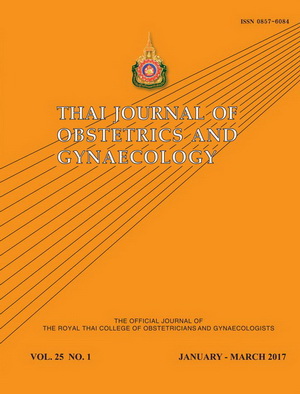Prevalence, Risk Factors, and Pregnancy Outcomes of Early-onset Severe Preeclampsia among Severe Preeclamptic Women in Siriraj Hospital
Main Article Content
Abstract
Objectives: To determine the prevalence, associated factors and outcomes of early-onset severe preeclampsia among severe preeclamptic women in Siriraj Hospital.
Materials and Methods: A total of 220 pregnant women diagnosed with severe preeclampsia were enrolled. Relevant data including obstetric data, diagnosis, treatment, route of delivery, maternal and neonatal outcomes were retrieved from medical records. Prevalence of early-onset severe preeclampsia (diagnosed before 34 weeks of gestation) was estimated. Various characteristics were compared between early and late-onset groups to determine associated risk factors.
Results: Mean age of pregnant women was 28.6 years, and 59.1% were nulliparous. Mean gestational age (GA) at first antenatal visit was 14.5 weeks and mean GA at delivery was 36.2 weeks. Prevalence of early-onset severe preeclampsia was 15.9%. Only 9.1% received expectant management and 32.7% delivered vaginally. Mean birth weight was 2514.1 g. Stillbirth, small for gestational age (SGA), birth asphyxia and neonatal intensive care unit (NICU) admission was found in 1.8%, 17.7%, 2.7%, and 6.8%, respectively. Mean GA at delivery was 30.6 weeks in early-onset group and 37.2 weeks among late-onset group. Early-onset group was more likely to receive expectant management than late-onset group (34.3% vs. 4.3%; p<0.001). Worse outcomes were more common among neonates of early-onset group and they were significantly more likely to require NICU admission (37.1% vs. 1.1%, p<0.001). Women with previous preeclampsia were significantly more likely to develop early-onset severe preeclampsia. (35.7% vs. 13.2%, p=0.037).
Conclusion: Prevalence of early-onset severe preeclampsia among preeclamptic women in Siriraj hospital was 15.9%. Worse neonatal outcomes were more commonly observed among early-onset cases. Previous preeclampsia was the only significant possible associated factors.

